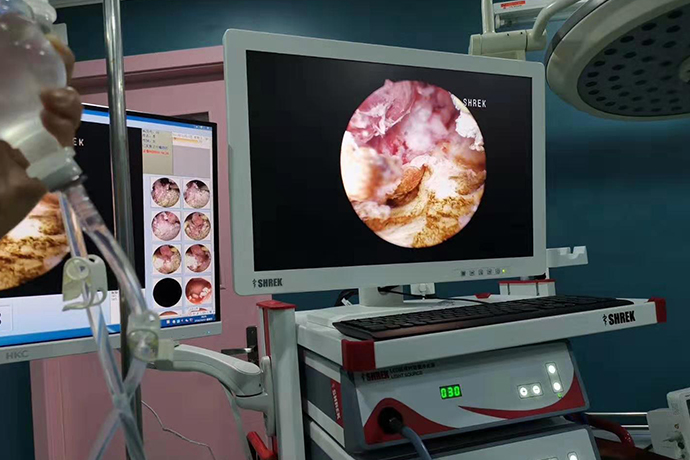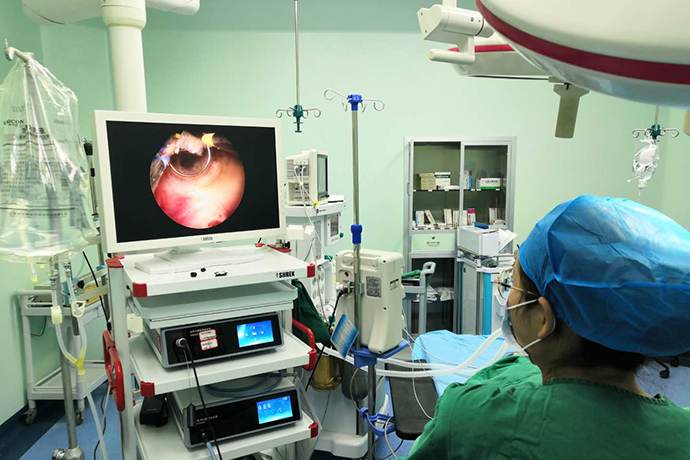【Hysteroscopy】Hysteromyomectomy
Release time: 02 Mar 2021 Author:Shrek
Introduction
Transcervical resection of myoma, TCRM; or transcervical resection of fibroid, TCRF, is the use of hysteroscopy to enter the uterine cavity from the cervical canal through the vagina, and remove the submucosa under hysteroscope surgery for fibroids.

Indications
1. Uterine submucosal fibroids, under normal circumstances, the diameter of fibroids is required to be less than 5cm.
2. For pedicled type I submucosal fibroids, sometimes the diameter of fibroids is greater than 5cm, even reaching 10cm, and there are successful TCRMs, depending on the level of the surgeon.
3. For small intramural fibroids that partially reach the endometrial surface, TCRM treatment can also be performed under ultrasound positioning
Surgical Steps
1. The patient's bladder lithotomy position, routine disinfection of drapes, gynecological examination to understand the size of the uterus, exposure and clamping of the cervix, and disinfection of the cervical canal.
2. Use diagnostic hysteroscopy to examine the cervical canal and uterine cavity to understand the location of uterine fibroids, the relationship with the uterine wall (that is, what type of fibroids), size, and whether there are other combined lesions in the uterine cavity. Withdraw from the hysteroscope body after the diagnosis is confirmed by hysteroscopy.
3. Uterine exploration and expansion of the cervical canal (generally expanded to size 10, depending on the size of the outer diameter of the resectoscope used).
4. Place the hysteroscopic resectoscopy with ring electrodes under direct vision.
5. Under the hysteroscope, use the ring electrode to passively remove the fibroids from the surface of the fibroids one by one until the fibroids are completely removed. During the resection, pay attention to distinguish the level of the fibroids and the uterine wall under the microscope, do not remove too deep and remove the muscle tissue, or even the possibility of uterine perforation; nor leave the fibroids.
6. Observe under the hysteroscope that after the myoma has been removed, there is no ejected bleeding point, and withdraw from the hysterectomy scope. Observe the uterine bleeding. If there is no obvious bleeding, end the operation; if there is obvious bleeding, analyze the cause and deal with it symptomatically (such as promoting uterine contractions, coagulation of bleeding arteries under hysteroscope, etc.)

Transcervical resection of myoma, TCRM; or transcervical resection of fibroid, TCRF, is the use of hysteroscopy to enter the uterine cavity from the cervical canal through the vagina, and remove the submucosa under hysteroscope surgery for fibroids.

Indications
1. Uterine submucosal fibroids, under normal circumstances, the diameter of fibroids is required to be less than 5cm.
2. For pedicled type I submucosal fibroids, sometimes the diameter of fibroids is greater than 5cm, even reaching 10cm, and there are successful TCRMs, depending on the level of the surgeon.
3. For small intramural fibroids that partially reach the endometrial surface, TCRM treatment can also be performed under ultrasound positioning
Surgical Steps
1. The patient's bladder lithotomy position, routine disinfection of drapes, gynecological examination to understand the size of the uterus, exposure and clamping of the cervix, and disinfection of the cervical canal.
2. Use diagnostic hysteroscopy to examine the cervical canal and uterine cavity to understand the location of uterine fibroids, the relationship with the uterine wall (that is, what type of fibroids), size, and whether there are other combined lesions in the uterine cavity. Withdraw from the hysteroscope body after the diagnosis is confirmed by hysteroscopy.
3. Uterine exploration and expansion of the cervical canal (generally expanded to size 10, depending on the size of the outer diameter of the resectoscope used).
4. Place the hysteroscopic resectoscopy with ring electrodes under direct vision.
5. Under the hysteroscope, use the ring electrode to passively remove the fibroids from the surface of the fibroids one by one until the fibroids are completely removed. During the resection, pay attention to distinguish the level of the fibroids and the uterine wall under the microscope, do not remove too deep and remove the muscle tissue, or even the possibility of uterine perforation; nor leave the fibroids.
6. Observe under the hysteroscope that after the myoma has been removed, there is no ejected bleeding point, and withdraw from the hysterectomy scope. Observe the uterine bleeding. If there is no obvious bleeding, end the operation; if there is obvious bleeding, analyze the cause and deal with it symptomatically (such as promoting uterine contractions, coagulation of bleeding arteries under hysteroscope, etc.)

Previous
【Thoracoscopy】Detailed Tunnel Method
- Recommended news
- 【General Surgery Laparoscopy】Cholecystectomy
- Surgery Steps of Hysteroscopy for Intrauterine Adhesion
- [Gynecological Hysteroscopy] Techniques for Preventing and Treating Complications of Hysteroscopic Surgery
- [Gynecological Hysteroscopy] Hysteroscopic Adhesiolysis
- [Gynecological Hysteroscopy] IUD Removal under Hysteroscopy